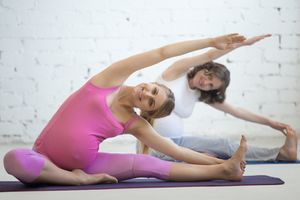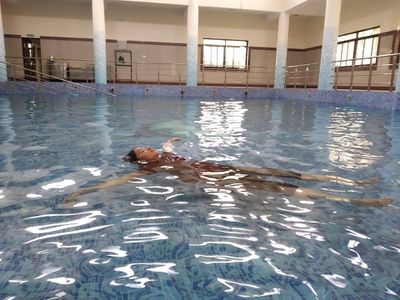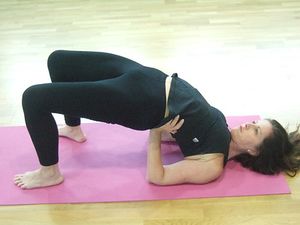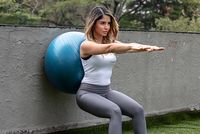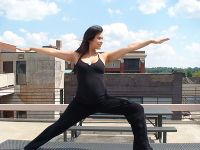Antenatal Exercises
One Page Owner - Rubi as part of the One Page Project
Introduction[edit | edit source]
Antenatal exercises aim at improving the physical and psychological well-being of an expected mother for labor and preventing pregnancy-induced pathologies by various physical means. It generally includes low impact aerobic exercises and stretching exercises.
During the first trimester, pregnancy brings certain changes in the body for example: morning sickness, fatigue or low energy levels, nausea and increased secretion of the relaxin hormone. Exercise helps to overcome these changes and improves the mood and energy level of the mother. Healthy pregnant women should exercise for at least 150 min per week or 20-30 min everyday in moderate to vigorous aerobic intensity.[1]
Guidelines for Physical Activity during Pregnancy
For more information-
- Physiological Changes in Pregnancy
- Postural Changes during Pregnancy
- Physical Activity and Pregnancy
Advantages of Antenatal Exercise[edit | edit source]
- Reduces morning sickness.
- Reduces insomnia, anxiety and stress.
- Reduces other pregnancy-related complaints, eg: fatigue, leg cramps, oedema of extremities, etc.
- Prevents excessive weight gain during pregnancy.
- Improves muscle strength.
- Improves core stability.
- Maintains muscle length and flexibility.
- Improves glycemic control[2].
- Improves posture.
- Enhances relaxation.
- Prepares for physical demands of labour.
Contraindications[edit | edit source]
There are absolute contraindications and relative contraindications.
Absolute contraindications[edit | edit source]
- Ruptured membranes
- Premature labour
- Unexplained PV bleeding
- Placenta previa after 28 weeks
- Pre-eclampsia
- Incompetent cervix
- Intrauterine growth restriction
- Higher-order multiple pregnancy (e.g., twins, triplets etc.)
- Uncontrolled high blood pressure, type 1 or type 2 diabetes or thyroid disease
- Other serious cardiovascular, respiratory or systemic disorders[3]
Relative contraindications[edit | edit source]
- Recurrent pregnancy loss
- Gestational hypertension
- A history of spontaneous preterm birth
- Mild/moderate cardiovascular or respiratory disease
- Symptomatic Anaemia
- Malnutrition
- Eating disorder
- Twin pregnancy after the 28th week
- Other significant medical conditions[4]
Precautions[edit | edit source]
- Exercises should be performed under supervision[5].
- Avoid supine lying more than 5 minutes after 3 months of gestation.
- Do not hold your breath(Valsalva's maneuver)[6].
- Do not change positions quickly.
- Stay hydrated at all times (before, during and after workouts).
- Follow proper warm-up and cool-down process.
- Ensure bladder emptying before workouts.
- Avoid exercises which demands higher balancing and different groups of muscles.
When to seek medical care?[edit | edit source]
- Excessively shortness of breath
- Chest pain or palpitations
- Dizziness
- Vaginal bleeding
- Abdominal pain
- Reduced fetal movement
- Painful uterine contractions(or prolonged uterine contractions)[7]
Let's take a glance at the various form of exercises which can be performed during pregnancy!
Cardiovascular Exercise[edit | edit source]
- The intensity of the workout will be decided by an assessment on pre-pregnancy fitness level.
- It is important to choose any aerobic activity based on one's interests, such as walking, swimming, hiking etc.
- So if walking is the only cardio workout done by an individual, it can be practiced 20-30 minutes 3-4 times a week safely.[8]
Stretching exercises[edit | edit source]
Pectoral stretch[edit | edit source]
- This exercise helps in the opening of the chest and prevents the development of round shoulders[10].
- Nudge the ball in the corner or near the wall.
- Sit in a comfortable position keeping the back on the ball.
- Keep your hands by the side or clasp them behind your head.
- Rest the head on ball and let the elbows expand and open your chest.
- Repeat 3 to 5 times.
Piriformis stretch[edit | edit source]
- Piriformis muscle plays an important role in pelvic stabilization and ADL's[12].
- Sit on the chair with neutral pelvis.
- Now keep your foot over the opposite knee and bend forward from the hips keeping your pelvis neutral until you feel the stretch.
- Hold it for 20-30 seconds.
- Repeat for the other side as well.
- Do 3 to 5 sets.
Hamstring stretch[edit | edit source]
- Shortening of hamstring can cause back pain[14] and pelvic misalignment.
- This stretch can be performed in various positions and bilaterally or unilaterally.
- Sit in long sitting position, bend one knee and try to reach your extended leg as much as you can.
- Hold it for 20-30 seconds and repeat it for 3-5 times on each side.
- During first trimester, supine lying hamstring stretch can also be done.
Calf stretch[edit | edit source]
- The more the available length of Tendo achilies, the more force production during push off phase of walking[16] and greater stability.
- Place rolled towel, mat or foam roller on the floor.
- Place ball of the foot on the towel, mat or roller and heel on the floor. keep the leg straight. hold this position for 20-30 seconds.
- Repeat on the other side and perform 3-5 sets on each side.
Strengthening Exercises[edit | edit source]
Wall push ups[edit | edit source]
- Place hands shoulder-width apart on a wall,
- Step your feet back so your body is in an inclined plank position.
- Slowly lower your chest, making sure your body stays in alignment.
- Exhale as you press back to the plank start position.
- Repeat 5-10 times.
Seated row back[edit | edit source]
- Sit or lean on a stability ball or bench with the adequate weighted dumbbell.
- Abduct your shoulders and bring your elbows almost your shoulder level.
- Exhale to engage as you push the elbows backwards and squeezing your shoulder blades together.
- Repeat it for 5-10 times.
Safety Considerations - Ensure you are sitting with a neutral pelvis and that the movement is from the arms, not the body.
both of theses exercises will prepare the expecting mother for breastfeeding and other baby carrying activities.
Bridging[edit | edit source]
- This exercise put more emphasis on the gluteus maximus and other larger postural muscles.
- Lie on your back, hands by your side, knee hip-width apart and heel under the knee.
- Keep your pelvis neutral, now squeeze your buttocks and lift the pelvis up.
- Hold it for 10-20 seconds, breath regularly.
- Come back to the starting position slowly.
Squats[edit | edit source]
- Great exercise for all the lower extremities muscle majorly focuses on gluteus maximus.
- Stand feet slightly more than hip width apart.
- Clasp the hands and bring them forward.
- Squat while exhaling and make sure knees won't go beyond the great toes.
- Press down and straighten the legs while going up.
- Ensure the stability.
Lunges[edit | edit source]
- This exercise put more emphasis on the gluteus,Hamstring and Quadriceps
- Stand straight, take one step forward.
- Now, lower yourself and try to maintain front leg vertical so that gluteus and hamstring will be loaded rather than quads.
- Pressing the leg down straighten yourself.
The Kegel's[edit | edit source]
Activities of Daily Living[edit | edit source]
- Staying active is advisable in pregnancy[20] until there is any risk associated.
- Walking, squatting, lifting and lunging activities should be included as far as possible, as it will prepare you for the Bib day!
- Make sure you are hydrated[21][22].
- Don't compete.
- Don't hold breath.
- While performing exercises, ensure that you won't exhaust yourself.
- Take enough rest intervals.
References[edit | edit source]
- ↑ Ferrari N, Graf C. Recommendations for physical activity during and after pregnancy. Gesundheitswesen (Bundesverband der Arzte des Offentlichen Gesundheitsdienstes (Germany)). 2017 Mar 1;79(S 01):S36-9.
- ↑ Hinman SK, Smith KB, Quillen DM, Smith MS. Exercise in pregnancy: a clinical review. Sports health. 2015 Nov;7(6):527-31.
- ↑ Artal R, O'toole M. Guidelines of the American College of Obstetricians and Gynecologists for exercise during pregnancy and the postpartum period. British journal of sports medicine. 2003 Feb 1;37(1):6-12.
- ↑ Mottola MF, Davenport MH, Ruchat SM, Davies GA, Poitras VJ, Gray CE, Garcia AJ, Barrowman N, Adamo KB, Duggan M, Barakat R. 2019 Canadian guideline for physical activity throughout pregnancy. British Journal of Sports Medicine. 2018 Nov 1;52(21):1339-46.
- ↑ Garnæs KK, Helvik AS, Stafne SN, Mørkved S, Salvesen K, Salvesen Ø, Moholdt T. Effects of supervised exercise training during pregnancy on psychological well-being among overweight and obese women: secondary analyses of the ETIP-trial, a randomised controlled trial. BMJ open. 2019 Nov 1;9(11).
- ↑ Hackett DA, Chow CM. The Valsalva maneuver: its effect on intra-abdominal pressure and safety issues during resistance exercise. The Journal of Strength & Conditioning Research. 2013 Aug 1;27(8):2338-45.
- ↑ Artal R, O’Toole M, American College of Obstetricians and Gynecologists. Exercise during pregnancy and the postpartum period. Clin Obstet Gynecol. 2003;46(2):496-9.
- ↑ Hinman SK, Smith KB, Quillen DM, Smith MS. Exercise in pregnancy: a clinical review. Sports health. 2015 Nov;7(6):527-31.
- ↑ AllBodiesFitness. Stability Ball Chest Stretch.available from:https://www.youtube.com/watch?v=jja2ZD9P7xg[ last accessed 24/09/2020 ]
- ↑ Kim MK, Lee JC, Yoo KT. The effects of shoulder stabilization exercises and pectoralis minor stretching on balance and maximal shoulder muscle strength of healthy young adults with round shoulder posture. Journal of physical therapy science. 2018;30(3):373-80.
- ↑ Royal Free London NHS Foundation Trust. piriformis stretch. available from:https://www.youtube.com/watch?v=JR1rtQ-PF38[last accessed 24/09/2020]
- ↑ Snijders CJ, Hermans PF, Kleinrensink GJ. Functional aspects of cross-legged sitting with special attention to piriformis muscles and sacroiliac joints. Clinical biomechanics. 2006 Feb 1;21(2):116-21.
- ↑ Pain therapy. Seated Hamstring Stretch 2. available from:https://www.youtube.com/watch?v=kWJQLTIvONY. [ Last accessed 24/09/2020 ]
- ↑ Deline A, Doubblestein D. The Relationship of Hamstring Length and Chronic Low Back Pain.
- ↑ NHS Ayrshire & Arran. Plantar Fascia Standing Calf Stretch (gastrocnemius and soleus muscles). available from:https://www.youtube.com/watch?v=2_2GMXTc1BE [ last accessed 24/09/2020 ]
- ↑ Hoang PD, Herbert RD, Todd G, Gorman RB, Gandevia SC. Passive mechanical properties of human gastrocnemius muscle–tendon units, muscle fascicles and tendons in vivo. Journal of Experimental Biology. 2007 Dec 1;210(23):4159-68.
- ↑ TD Fitness. Prenatal Fitness - Wall Push Up. Available from :https://www.youtube.com/watch?v=3dcDbbUDCtU [last accessed 23/09/2020]
- ↑ Eric Johannsen. Pregnancy Dumbbell Row Exercise Video - Upper Body Weight Training. Available from:https://www.youtube.cch?v=Sg-f5rig6qgom/wat. [ last accessed 24/09/2020]
- ↑ Mater. Pelvic floor exercises during pregnancy. Available from:https://www.youtube.com/watch?v=OArrUPQqCHM [last accessed 24/09/2020]
- ↑ Borodulin K, Evenson KR, Wen F, Herring AH, Benson A. Physical activity patterns during pregnancy. Medicine and science in sports and exercise. 2008 Nov;40(11):1901.
- ↑ Sawka MN. Physiological consequences of hypohydration: exercise performance and thermoregulation. Medicine and science in sports and exercise. 1992 Jun;24(6):657-70.
- ↑ El-Sharkawy AM, Sahota O, Lobo DN. Acute and chronic effects of hydration status on health. Nutrition reviews. 2015 Sep 1;73(suppl_2):97-109.
